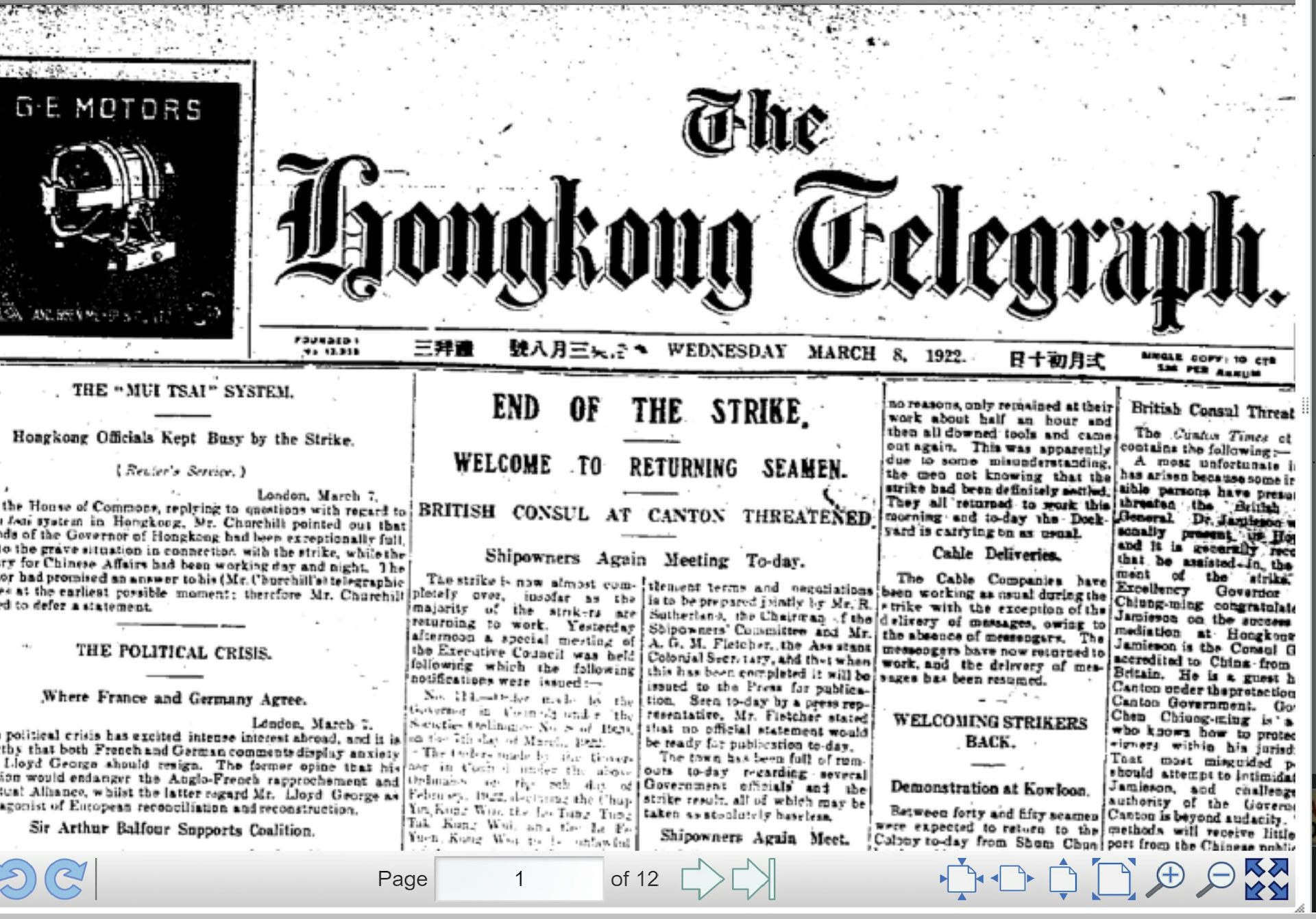You are here
Hong Kong’s 1922 general strike: when the British empire struck back
Hong Kong’s 1922 general strike: when the British empire struck back
August 2, 2022 https://theconversation.com/hong-kongs-1922-general-strike-when-the-brit...
Following last year’s centenary of the foundation of the Chinese Communist Party (CCP), 2022 marks the 100th anniversary of the first general strike to shut down a British colonial territory – Hong Kong.
The strike began with the grievances of the British territory’s seamen, but rapidly spread to other sectors, effectively shutting Hong Kong down. It represents the first major episode of industrial unrest in the territory, to which the colonial authorities responded with emergency anti-strike legislation. The law introduced by the colonial authorities, which allowed the governer to pass “any regulations whatsoever which he may consider desirable in the public interest”, was used in 2019 to ban the use of face masks by protesters.
The CCP was founded only a few months before the strike began, but there is little evidence that the strike was led by the party. But many militants later joined the CCP and were very influential in much larger strikes in 1925 and 1926. It was the militancy of the strikes of 1920 to 1925 in China that shaped the formative years of Chinese communism rather than the party being in the vanguard of revolutionary activism.
The General Industrial Federation of Chinese Seamen (Zhonghua Haiyuan Gongye Lianhe Zonghui) had been established in March 1921 and its grievances were largely about payment. Inequity in payment between Chinese and non-Chinese seamen was stark – there was clearly an anti-imperialist dimension to the strike. The wage workers of Hong Kong were taking direct action against colonial businesses supported by the colonial government.
Gathering unrest
In 1921, demands for wage rises were generally ignored by shipping companies. The seamen’s union became increasingly determined. On January 12 1922 it again pressed the case for wage increases, setting a 24-hour limit for a response. The following day, 1,500 deck hands and stokers went on a 52-day strike. During the second half of January the number on strike grew to about 30,000. By early February, 167 steamers were moored and disabled causing serious losses to shipping companies.
Solidarity strikes had been planned from the start, with agreements to support the seamen. About 50,000 workers of all kinds were involved by the middle of February, including office workers, cooks, bakers, rickshaw pullers and even the Chinese staff of Government House. Transport services were halted.
By the end of the strike there was a complete paralysis of economic life in Hong Kong. It was estimated by the main English-language paper in Hong Kong, the South China Morning Post (SCMP) – whose archives are unfortunately not available online – that 120,000 workers went on strike.
More than 50% of the strikers were not part of the shipping industry. So this this movement represented a “general strike”, rather than just a seamen’s strike.
Violent reaction
Britain’s colonial administration – with support from the Westminster government – declared the strike illegal on February 1 and the government tried to repress industrial action by introducing emergency regulations. Hong Kong’s governor was given power to make “any regulations whatsoever which he may consider desirable in the public interest”.
According to the Government Gazette from February 28 1922, departures from Hong Kong without travel passes were forbidden. This was a critical issue. The union had moved its organisation to nearby Canton (now Guangzhou) on the Chinese mainland, where the local government gave support to strikers, including strike pay.
On March 3, according to a subsequent report in the SCMP of proceedings at the coroner’s court, more than 2,000 strikers decided to walk to Canton. When they tried to break through a cordon, an order to fire was given to troops. Four people were seriously injured and died at the scene.
The SCMP maintained good coverage. Only at the end of the strike was its own printing press closed temporarily. After being unable to publish on the previous day, the March 7 edition was a single page with the headline “Peace Celebrations”.
Temporary truce
The chairman of the Shipowners’ Committee wrote to the Hong Kong governor on March 15 with details of the settlement. At least on paper, the strikers were victorious. Wage rises of 15% to 30% were promised. Restrictions on the seamen’s union were lifted. There were to be no reprisals and imprisoned strikers would be released.
There may have been some temporary material improvement, but labour was engaged through contractors who took a big “top slice” known as the “squeeze”. Formal wage rises would have been notional because workers were paid indirectly using a “labour gang” system.
Management rarely had any reliable record of its workers. Companies agreed a fixed sum with an intermediary who would do the hiring, pay the workers, and often found their accommodation when not at sea.
Similar systems persisted throughout China until 1949, because there were large numbers willing to migrate from the impoverished agrarian sector. An economic strike was turned into a major political confrontation by government repression and inept response.
Union militancy drove CCP development rather more than the party leading the strikers. The CCP in Hong Kong only became an organised group during the next three years.
The Hong Kong general strike demonstrated to the recently created CCP that union militancy could be very powerful. Connected with other outbreaks of strike action – and at a time of optimism that the Russian example would be followed in other countries – CCP leaders became increasingly confident that revolution would soon sweep though the cities of China.
But after urban uprisings of 1927 were crushed, a new view – Mao’s advocacy of rural insurgency – began to take root. By 1949 the CCP took control across China. Hong Kong itself returned to Chinese rule in 1997, where – 22 years later – the government of the special administrative region themselves used the 1922 Colonial Emergency Laws to deal with unrest and activism.

